Mario Party 7 Box Art Mario Party 7 Grand Canal Music
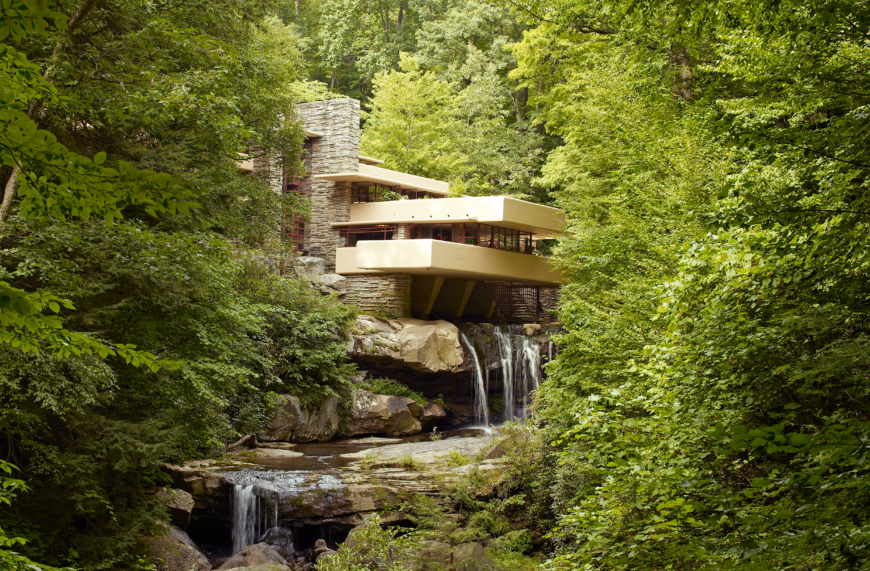
Frank Lloyd Wright, Fallingwater (Edgar J. Kaufmann House), 1935–38, Bear Run, Pennsylvania (photograph: Carol M. Highsmith Archive, Library of Congress)
Perched in a higher place a mountain cataract on a rocky hillside deep in the rugged forest of Southwestern Pennsylvania, some 90 minutes from Pittsburgh, is America's most famous house. The commission for Fallingwater was a personal milestone for the American architect Frank Lloyd Wright, since information technology conspicuously marked a turning indicate in his career. After this belatedly-career triumph, the sixty-7 twelvemonth old would keep to create a series of highly original designs that would validate his claim as "The world's greatest architect."
"The greatest builder of the nineteenth-century" —Philip Johnson
The mid-1930s were among the darkest years for architecture and architects in American history; the state's fiscal system had complanate with the failure of hundreds of banks. Most no individual homes were congenital. Many of the architectural projects started during the blast of the tardily 1920s were halted for lack of funds. Now in his sixties, Wright and his new wife Olgivanna were struggling to keep Taliesin, his Wisconsin habitation and studio, out of foreclosure. Worse still, his peers were get-go to regard Wright as an irrelevant anachronism whose time had passed.
In 1932 Henry-Russell Hitchcock and Philip Johnson opened the "Modern Architecture: International Exhibition" at the newly founded Museum of Modern Art in New York and simultaneously published the bookInternational Style. This was, peradventure, the almost influential architectural exhibit ever mounted in the United states of america and the book became a manifesto for modernistic compages and would greatly affect almost every major architectural project worldwide for the next thirty years. Information technology focused on the piece of work of four cracking "European functionalists" Walter Gropius, Ludwig Mies van der Rohe, Le Corbusier, and J.J.P. Oud. Wright was largely snubbed.
Hitchcock had praise for his early work, for its "many innovations," only he condemned Wright for a "[50]ack of continuity in his development and his unwillingness to blot the innovations of his contemporaries and his juniors in Europe." Hitchcock insulted Wright further by characterizing him equally "a rebel past temperament… [who] refused even the discipline of his ain theories." The catalogue calls Wright a "half-modern" throwback, 1 of the "final representatives of Romanticism." Wright responded by denigrating European Modernism as an "evil cause," a manifestation of "totalitarianism."
A fellowship and a committee
The Wrights devised an architectural apprenticeship program that came to be known as the "fellowship." And among the outset candidates was Edgar Kaufmann Jr. who became enamored with Wright afterwards reading his biography. Kaufmann was the son of Pittsburgh section store tycoon Edgar Kaufmann Sr., whose thirteen-story downtown Pittsburgh emporium was reported to be the largest in the globe. Kaufmann senior was no stranger to architectural pursuits—he was involved in numerous public projects and built several stores and homes. Kaufmann let Wright know that he had several borough architectural projects in mind for him. He and his wife Liliane were invited to Taliesin and were duly impressed.
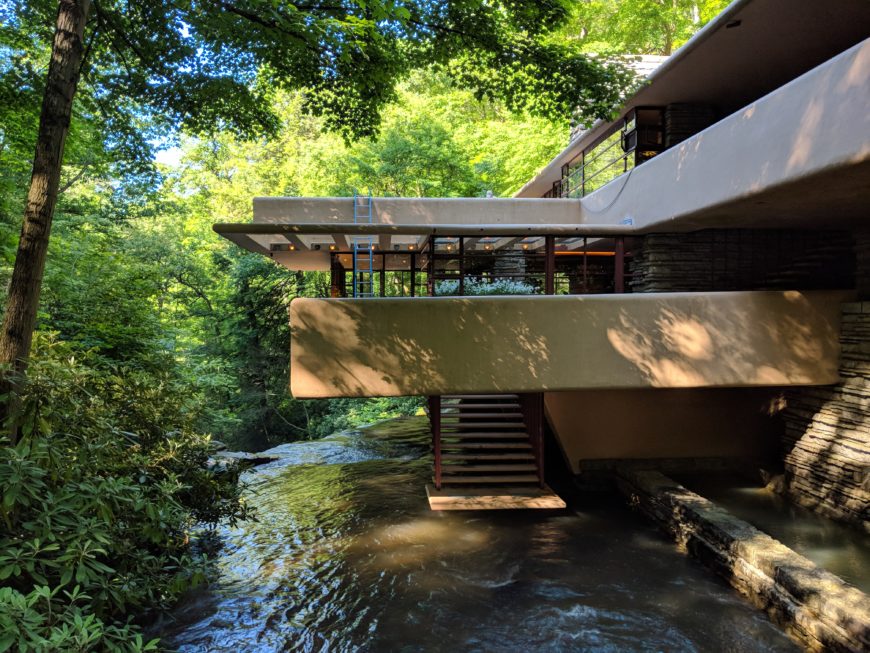
Frank Lloyd Wright, Fallingwater, steps to stream (Edgar J. Kaufmann Business firm), Behave Run, Pennsylvania (photo: Jon Fisher, CC Past-NC-ND 2.0)
There are varying accounts regarding the circumstances that brought Kaufmann to offer Wright a chance to design a "weekend habitation" in the country; but we know that Wright made his first trip to the site on Bear Run, Pennsylvania, in December, 1934. Wright'south amateur Donald Hoppen has spoken of Wright's "uncanny sense of…genius loci"1 (Latin for "spirit of the place") and from the very beginning, the builder rejected a site that presented a conventional view of the waterfall; instead, he audaciously offered to brand the business firm function of it, stating that the "visit to the waterfall in the forest stays with me and a home takes shape in my listen to the music of the stream." The South-southeast orientation gives the illusion that the stream flows, not alongside the house, but through it.
Fastest depict in the Midwest
Perhaps the most famous tale to come up out of the lore of Fallingwater is the improbable story that Wright, later on receiving the commission, procrastinated for nine months until he was forced to depict upwards the consummate plans while his patron was driving the 140 miles from Milwaukee to Taliesin. However, the essential story is validated by several witnesses. Apprentice Edgar Taffel recalled that after talking with Kaufmann on the phone, Wright "briskly emerged from his office…sat down at the table set with the plot plan and started to draw…The design just poured out of him. 'Liliane and E.J. volition take tea on the balcony…they'll cross the bridge to walk in the wood…' Pencils being used up equally fast as nosotros could acuminate them….Erasures, overdrawing, modifying. Flipping sheets back and forth. Then, the bold title across the lesser 'Fallingwater.' A house has to accept a name."two There seems to be agreement that the whole procedure took about two hours.
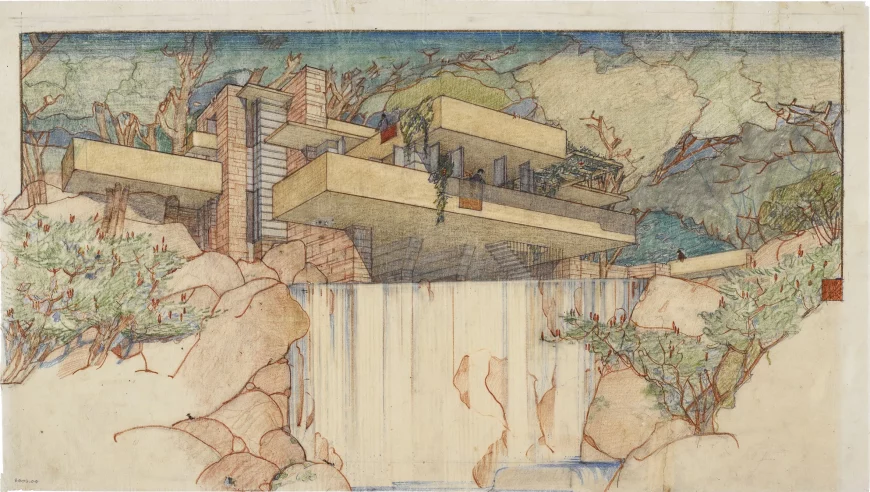
Frank Lloyd Wright, Fallingwater (Edgar J. Kaufmann House), Mill Run, Pennsylvania, 1935, Color pencil on tracing paper, 15-3/eight x 27-ane/4″ © The Frank Lloyd Wright Foundation
Organic architecture
Edgar Kaufmann Jr. pointed out that Wright's famous concept of "Organic Architecture" stems from his Transcendentalist background. The belief that man life is office of nature. Wright even incorporated a rock outcropping that projected to a higher place the living room flooring into his massive primal hearth, further uniting the business firm with the globe. "Can you say," Wright challenged his apprentices, "when your building is consummate, that the landscape is more than beautiful than information technology was before?"3
In his book, Fallingwater Rising: Frank Lloyd Wright, E. J. Kaufmann, and America's Most Extraordinary Business firm, Franklin Toker wrote that,
this delicate synthesis of nature and the built environment probably counts as the main reason why Fallingwater is such a well-loved piece of work. The contouring of the house into cantilevered ledges responds so sympathetically to the rock strata of the stream banks that it does brand Bear Run a more wondrous landscape than it had been before.4
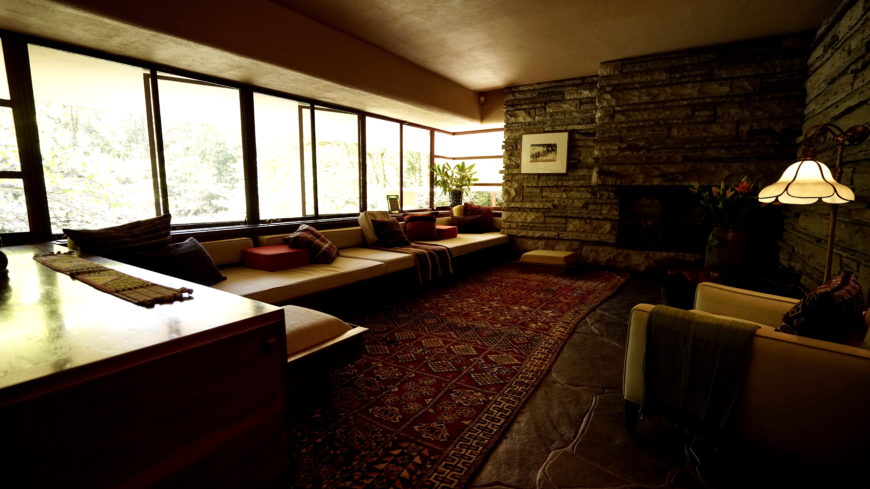
Frank Lloyd Wright, Fallingwater (Edgar J. Kaufmann House), Deport Run, Pennsylvannia, 1937 (photo: Jeremy Weate, CC Past 2.0)
Wright further emphasizes the connection with nature by liberal use of drinking glass; the house has no walls facing the falls, only a central stone cadre for the fireplaces and stone columns. This provides elongated vistas leading the eye out to the horizon and the woods. Vincent Scully has pointed out that this reflects "an image of Modern human being caught upwards in constant change and flow, belongings on…to whatever seems solid but no longer regarding himself equally the center of the world."v The architect's creative use of "corner turning windows" without mullions causes corners to vanish. Wright even bows to nature by angle a trellis beam to accommodate a pre-existing tree.
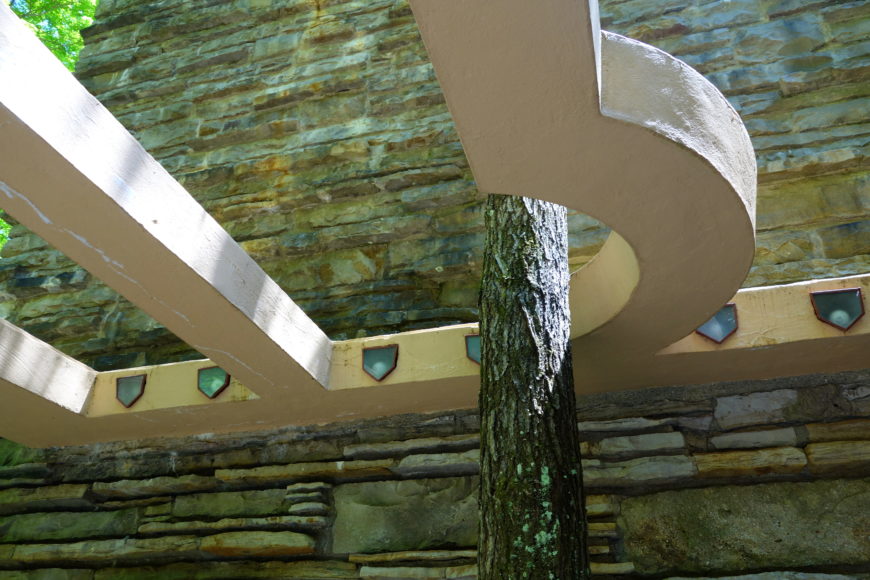
Frank Lloyd Wright, Fallingwater, item with tree (Edgar J. Kaufmann House), 1937 (photograph: Daderot, CC0 1.0)
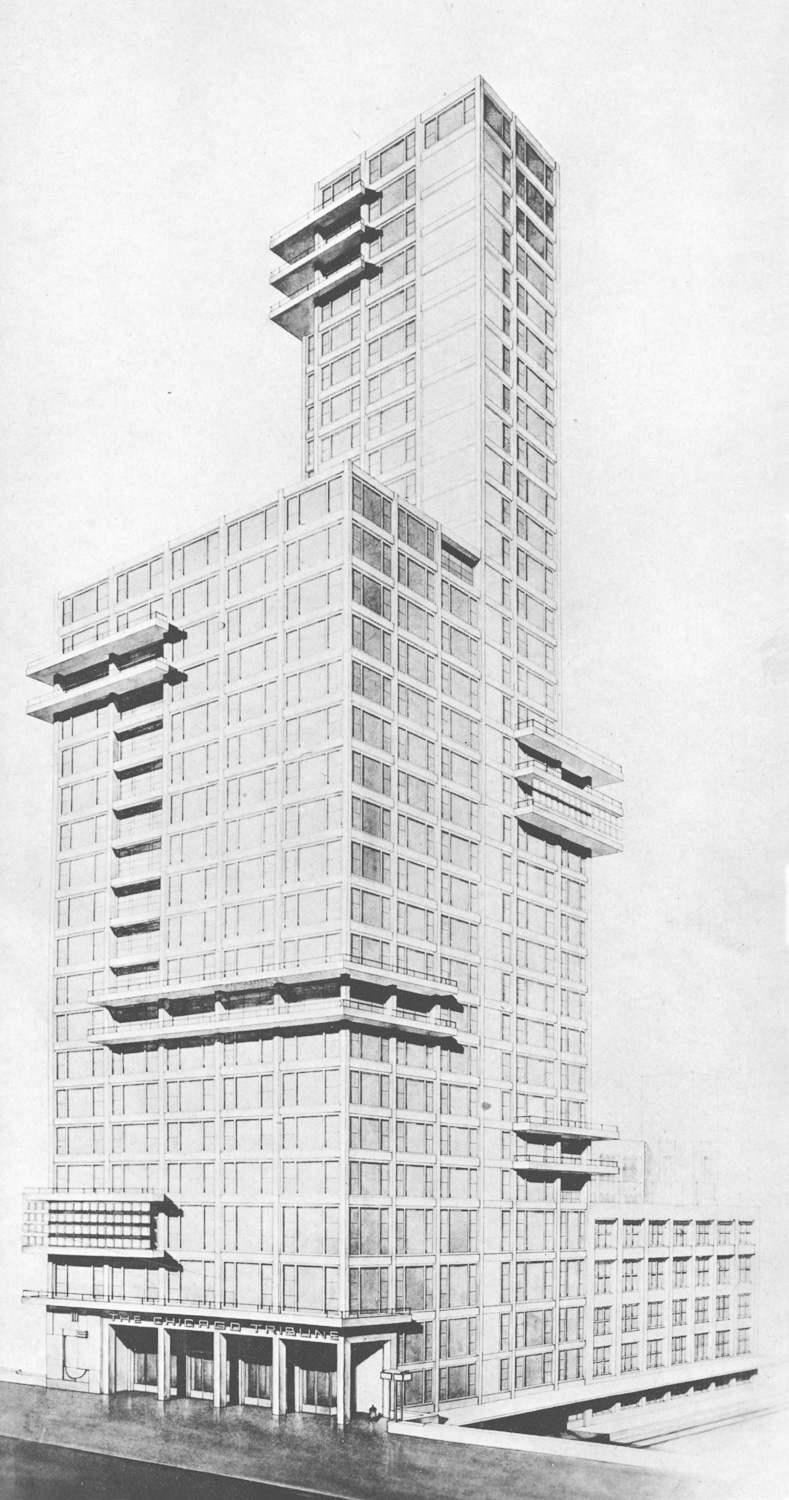
Walter Gropius and Adolf Meyer, competition entry for the Chicago Tribune Tower, 1922, perspective drawing, 22.v x 13.iii cm, gelatin silvery impress sheet (Harvard Art Museums)
Influences
Although he denied information technology, Wright was influenced past every believable architectural way, but Fallingwater owes petty to his previous designs (the only exceptions being perchance the use of irregular stones that are also found on Taliesin and his interest in strong horizontal lines). At Fallingwater, he appears to be more than concerned with responding to the European Modernist design that he had in function inspired—but that had since eclipsed him. In consequence, he gear up out to beat the Europeans at their own game, using elements of their idiom. We run across, for instance, inspiration fatigued from the balconies of Gropius' blueprint for the Chicago Tribune Tower competition, though instead of the stark white of the International Style, he paints his balconies a warmer, earthen tone in deference to nature and possibly the Adobe dwellings of the American Southwest.
Fallingwater falling down?
The Kaufmanns loved Wright's radical proposal to literally suspend the business firm over the waterfall. Simply Edgar Kaufmann Sr., ever the pragmatic business organization man (who had also studied engineering for a year at Yale) prudently sent a copy of Wright'due south blueprints to his engineer; who establish the ground unstable and did non recommend that he proceed with the house. Wright was non happy with his client's lack of faith, but permitted an increment in the number and diameter of the structure'southward steel reinforcements—Kaufmann agreed to proceed. It's worth noting that the engineer's warnings subsequently proved valid, an issue that "haunted" Wright for the balance of his life.
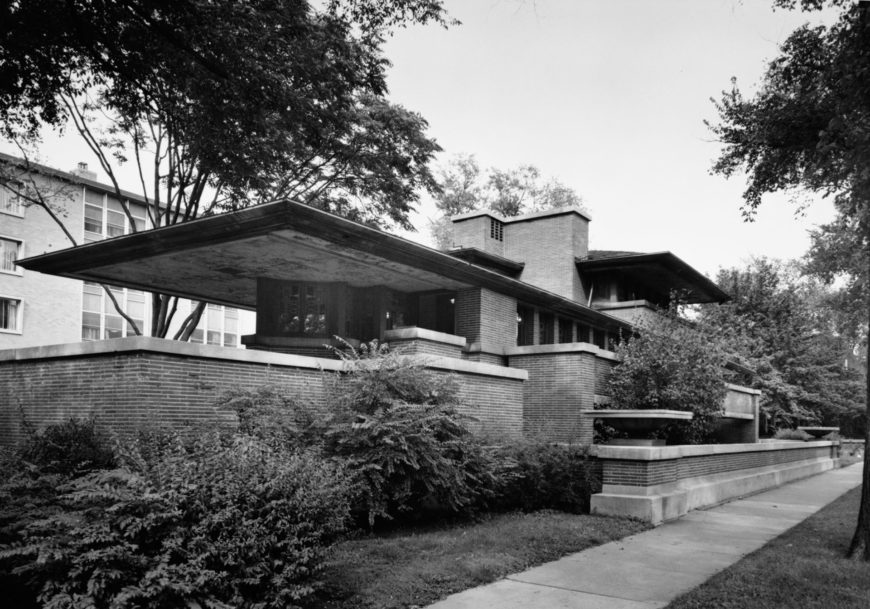
Frank Lloyd Wright, Frederick C. Robie House, Historic American Buildings Survey, Cervin Robinson, Photographer, xviii August 1963, exterior from southwest, 5757 Woodlawn Artery, Chicago, Cook Canton, IL, v x 7″ (Library of Congress HABS ILL,16-CHIG,33–3)
Wright is famous for pushing the architectural envelope for dramatic outcome. We come across this is in the vast cantilevered wooden roof of Robie House in Chicago. In Fallingwater he chose ferro-physical for his cantilevers, this use of reinforced concrete for the long suspended balconies was revolutionary. He boldly extended the balcony of the second floor chief bedroom soaring half-dozen feet beyond the living room below.
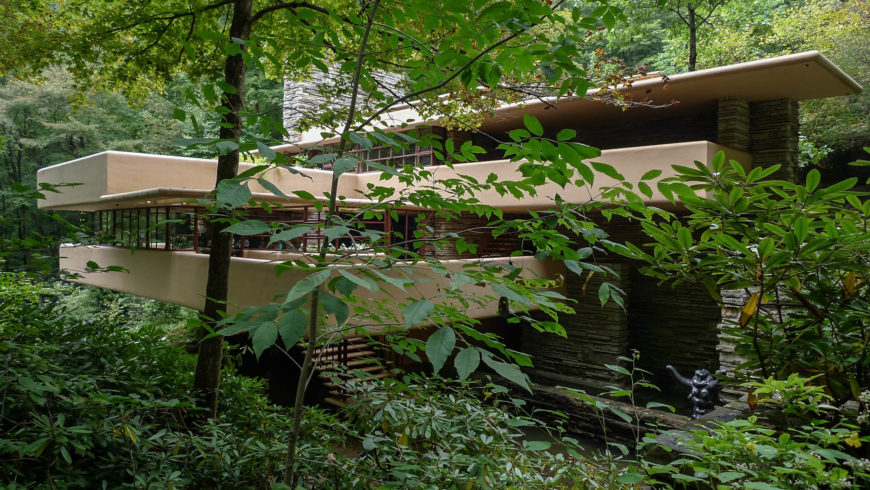
Frank Lloyd Wright, Fallingwater, steps to stream (Edgar J. Kaufmann Business firm), Bear Run, Pennsylvania (photo: James Finister, CC BY-NC-ND 2.0)
However, due to the lack of proper support, cracks began appearing in the balustrade floors soon after they were poured. Over the years since, cracks have been repeatedly repaired equally the cantilevers continued to sag. By 2001 some of the 15 pes cantilevers had fallen more than than vii inches. To avoid a complete collapse, an ingenious system was devised using tensioned cables to correct the trouble and stabilize Wright's masterwork.
Almost from the mean solar day of its completion, Fallingwater was historic effectually the world. The house and its architect were featured in major publications including the cover of Time Mag. Over the years its fame has just increased. According to Franklin Toker, Fallingwater'due south most important contribution to Modern Compages is surely the "acceptance of Modern architecture itself."
Notes
1. Donald W. Hoppen, The Seven Ages of Frank Lloyd Wright: The Artistic Procedure, Dover Publications: New York, 1993, folio 23.
2. Edgard Tafel, Years with Frank Lloyd Wright: Apprentice to Genius, Courier Dover Publications, 1979.
3. Hoppen, page 97.
4. Franklin Toker,Fallingwater Ascension: Frank Lloyd Wright, E. J. Kaufmann, and America'south Most Extraordinary Business firm, Alfred A. Knopf: New York, 2003, np.
5. Meryle Secrest, Frank Lloyd Wright: A Biography, University of Chicago Press: Chicago, 1992, page 168.
Boosted resources
Architectural drawings of Fallingwater: plans, elevations
Fallingwater website
3D model video wing-through
Source: https://smarthistory.org/frank-lloyd-wright-fallingwater/
0 Response to "Mario Party 7 Box Art Mario Party 7 Grand Canal Music"
Post a Comment